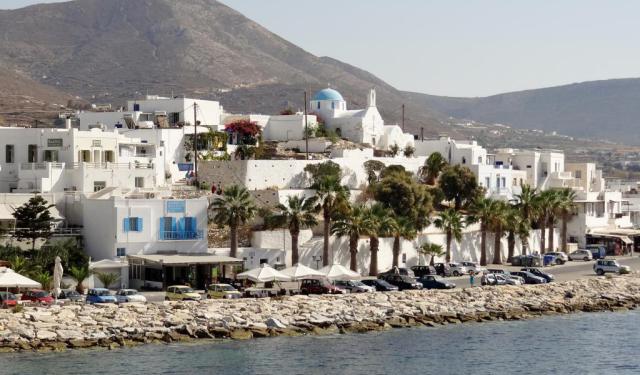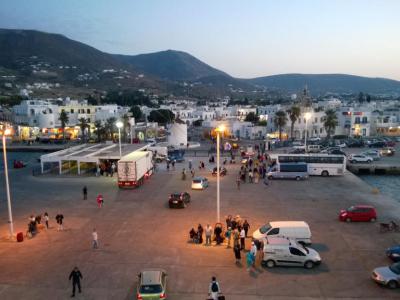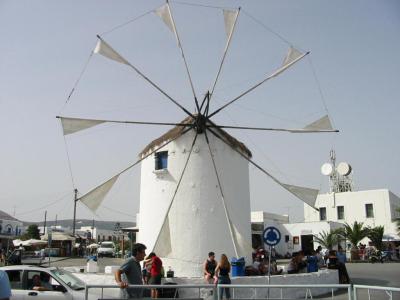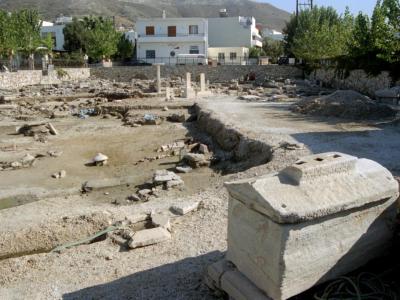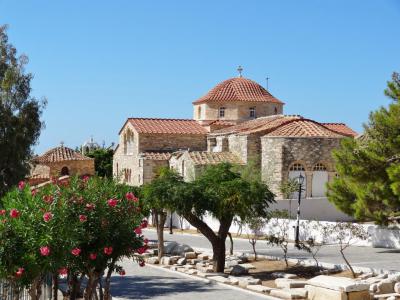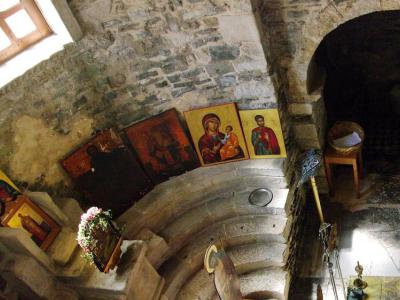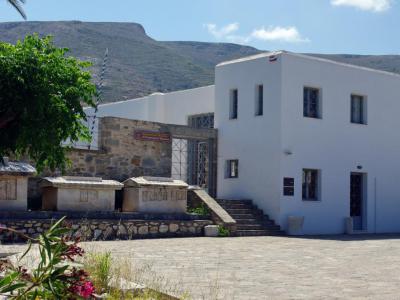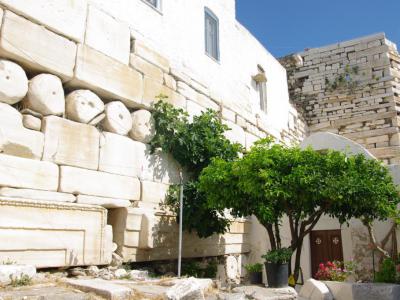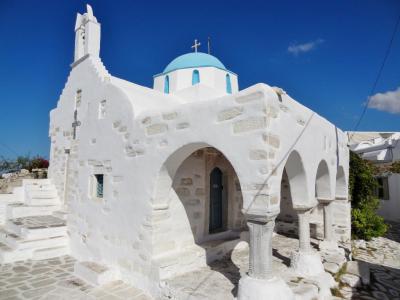Parikia Introduction Walking Tour (Self Guided), Paros
Parikia, the historic capital of Paros island in the Aegean Sea, is the epicenter of local life and commerce. This picturesque town is one of the most typical Cycladic settlements and is distinguished by its narrow cobbled paths, old churches, small shops, and houses of white and blue.
A bustling nucleus of activity, Parikia caters to both tourists and locals alike with its budget-friendly prices and a wide array of readily available goods, all of which give it an unfiltered, authentic atmosphere.
Parikia has been inhabited since antiquity. Its name is believed to be stemming from the words "Paria lithos," a reference to the island's famous white marble that was extensively quarried here in ancient times.
One of the town's most prominent features is the Parikia Port. As you stroll along the waterfront, you can soak in the atmosphere and witness the convergence of modern life with the town's storied past.
Dominating the skyline is the iconic Windmill of Parikia, a symbol of Paros. This well-preserved piece of machinery serves as a reminder of the island's past reliance on wind power.
Venturing further, history enthusiasts will discover the Ancient Cemetery, offering a glimpse into the lives of the town's earliest inhabitants.
The most famous monument in Parikia is the Church of Virgin Mary, also known as Panagia Ekatontapiliani, which means "the Church of 100 doors". A testament to the town's Byzantine legacy, this ecclesiastical complex has many interesting frescoes on its walls.
The Byzantine Museum and Archaeological Museum are treasure troves of artifacts, showcasing the island's history and cultural heritage.
A visit to Parikia would be incomplete without exploring yet another local trademark, the imposing Frankish Castle. Overlooking the town, this fortification was built by the Venetians in the early 17th century using the remains of ancient temples.
Last but not least, the Church of Saint Konstantine (Agios Konstantinos) provides a spiritual respite in the heart of the city.
Wandering through Parikia's narrow streets, you can absorb its historical charm and be captivated by it. So, start planning your trip to Parikia now and prepare to indulge in its beauty.
A bustling nucleus of activity, Parikia caters to both tourists and locals alike with its budget-friendly prices and a wide array of readily available goods, all of which give it an unfiltered, authentic atmosphere.
Parikia has been inhabited since antiquity. Its name is believed to be stemming from the words "Paria lithos," a reference to the island's famous white marble that was extensively quarried here in ancient times.
One of the town's most prominent features is the Parikia Port. As you stroll along the waterfront, you can soak in the atmosphere and witness the convergence of modern life with the town's storied past.
Dominating the skyline is the iconic Windmill of Parikia, a symbol of Paros. This well-preserved piece of machinery serves as a reminder of the island's past reliance on wind power.
Venturing further, history enthusiasts will discover the Ancient Cemetery, offering a glimpse into the lives of the town's earliest inhabitants.
The most famous monument in Parikia is the Church of Virgin Mary, also known as Panagia Ekatontapiliani, which means "the Church of 100 doors". A testament to the town's Byzantine legacy, this ecclesiastical complex has many interesting frescoes on its walls.
The Byzantine Museum and Archaeological Museum are treasure troves of artifacts, showcasing the island's history and cultural heritage.
A visit to Parikia would be incomplete without exploring yet another local trademark, the imposing Frankish Castle. Overlooking the town, this fortification was built by the Venetians in the early 17th century using the remains of ancient temples.
Last but not least, the Church of Saint Konstantine (Agios Konstantinos) provides a spiritual respite in the heart of the city.
Wandering through Parikia's narrow streets, you can absorb its historical charm and be captivated by it. So, start planning your trip to Parikia now and prepare to indulge in its beauty.
How it works: Download the app "GPSmyCity: Walks in 1K+ Cities" from Apple App Store or Google Play Store to your mobile phone or tablet. The app turns your mobile device into a personal tour guide and its built-in GPS navigation functions guide you from one tour stop to next. The app works offline, so no data plan is needed when traveling abroad.
Parikia Introduction Walking Tour Map
Guide Name: Parikia Introduction Walking Tour
Guide Location: Greece » Paros (See other walking tours in Paros)
Guide Type: Self-guided Walking Tour (Sightseeing)
# of Attractions: 8
Tour Duration: 1 Hour(s)
Travel Distance: 1.5 Km or 0.9 Miles
Author: DanaOffice
Sight(s) Featured in This Guide:
Guide Location: Greece » Paros (See other walking tours in Paros)
Guide Type: Self-guided Walking Tour (Sightseeing)
# of Attractions: 8
Tour Duration: 1 Hour(s)
Travel Distance: 1.5 Km or 0.9 Miles
Author: DanaOffice
Sight(s) Featured in This Guide:
- Parikia Port
- Windmill of Parikia
- Ancient Cemetery
- Church of Virgin Mary with a Hundred Doors
- Byzantine Museum
- Archaeological Museum
- Frankish Castle
- Agios Konstantinos (St. Konstantine Church)
1) Parikia Port
Parikia Port is strategically situated on the western side of Paros, making it easily accessible for travelers arriving on the island. It boasts a prime location within the capital city, surrounded by various accommodations, restaurants, shops, and attractions.
The port offers ferry connections to various destinations, with ferries departing from Athens, including Piraeus, Rafina, and Lavrio, serving as primary departure points. Travelers can access Paros from these ports, as well as from other Greek islands such as Naxos, Santorini, Mykonos, Crete, and more. Parikia Port is equipped with a bus station located conveniently to the right as passengers disembark from the ferry.
The port area is often considered the heart of Parikia, with a notable windmill that once served as a tourist information center. While it no longer functions as an information center, it remains a charming symbol of the town.
Parikia Port is surrounded by numerous cafes along the coast and up the main street, offering travelers the opportunity to enjoy frappes, espressos, and a variety of fast food options. For those seeking a picturesque sunset experience, the cafes along the coast, particularly the Glass Cafe, offer stunning vistas of the setting sun over the Aegean Sea. In addition to cafes, Parikia Port features a variety of dining establishments, including fish tavernas and psistarias (grilled meat restaurants), where visitors can savor delicious Greek cuisine and fresh seafood.
The port offers ferry connections to various destinations, with ferries departing from Athens, including Piraeus, Rafina, and Lavrio, serving as primary departure points. Travelers can access Paros from these ports, as well as from other Greek islands such as Naxos, Santorini, Mykonos, Crete, and more. Parikia Port is equipped with a bus station located conveniently to the right as passengers disembark from the ferry.
The port area is often considered the heart of Parikia, with a notable windmill that once served as a tourist information center. While it no longer functions as an information center, it remains a charming symbol of the town.
Parikia Port is surrounded by numerous cafes along the coast and up the main street, offering travelers the opportunity to enjoy frappes, espressos, and a variety of fast food options. For those seeking a picturesque sunset experience, the cafes along the coast, particularly the Glass Cafe, offer stunning vistas of the setting sun over the Aegean Sea. In addition to cafes, Parikia Port features a variety of dining establishments, including fish tavernas and psistarias (grilled meat restaurants), where visitors can savor delicious Greek cuisine and fresh seafood.
2) Windmill of Parikia
Throughout the Greek islands, especially in the Cyclades, traditional whitewashed windmills are emblematic of the local architectural style. These windmills are not only visually striking but also historically significant. In the past, windmills like the one in Parikia played a vital role in the lives of the local population. Using the power of the strong Cycladic winds, these windmills were used to grind wheat, a crucial staple in the islanders' diet during the 19th century.
Over time, some windmills have been preserved in their traditional form, while others have undergone renovation and repurposing. Today, they serve various functions, such as hotels, cafeterias, and art galleries.
The traditional windmill in Parikia is a prominent landmark and often the first sight that greets visitors arriving on the island by ferry. Its location at the bustling port of Parikia makes it a central and easily recognizable point of interest.
The Windmill of Parikia has been meticulously restored to its original form, preserving its traditional character. This restoration allows visitors to appreciate its historical significance and architectural beauty. The windmill serves as a symbol of Paros, reflecting the island's rich cultural heritage and its connection to the Cycladic tradition.
Over time, some windmills have been preserved in their traditional form, while others have undergone renovation and repurposing. Today, they serve various functions, such as hotels, cafeterias, and art galleries.
The traditional windmill in Parikia is a prominent landmark and often the first sight that greets visitors arriving on the island by ferry. Its location at the bustling port of Parikia makes it a central and easily recognizable point of interest.
The Windmill of Parikia has been meticulously restored to its original form, preserving its traditional character. This restoration allows visitors to appreciate its historical significance and architectural beauty. The windmill serves as a symbol of Paros, reflecting the island's rich cultural heritage and its connection to the Cycladic tradition.
3) Ancient Cemetery
Excavations conducted in 1983 unveiled the Ancient Cemetery, shedding light on its existence. The cemetery's origins date back to the late 8th century BC, and it remained in use until the 3rd century AD, spanning several centuries of Parian history.
Situated near the port of Parikia, the cemetery lies alongside the coastal road, making it accessible to visitors and locals alike. The Ancient Cemetery comprises various types of tombs that reflect different eras and burial customs. These tombs offer valuable insights into the evolution of Parian society and funerary practices over time.
One of the most remarkable discoveries at the cemetery is the presence of a polyandreion, a group tomb. Notably, it is the sole polyandreion found in the entire Aegean region. This particular tomb dates back to the late Geometric period, around the 8th century BC, showcasing the island's ancient roots. Standing prominently before the polyandreion is a massive headstone, a significant feature of this unique archaeological site. This headstone likely played a role in commemorating the individuals interred within the group tomb.
Today, the Ancient Cemetery in Parikia has been transformed into an archaeological park, allowing visitors to explore its historical significance and cultural heritage. The site provides a window into the island's past through its well-preserved tombs and artifacts. Adjacent to the cemetery, a display center offers visitors a deeper understanding of the site's historical and archaeological significance. Inside, you can find intriguing discoveries and photographs from past and ongoing excavations, providing valuable context to the ancient cemetery.
Situated near the port of Parikia, the cemetery lies alongside the coastal road, making it accessible to visitors and locals alike. The Ancient Cemetery comprises various types of tombs that reflect different eras and burial customs. These tombs offer valuable insights into the evolution of Parian society and funerary practices over time.
One of the most remarkable discoveries at the cemetery is the presence of a polyandreion, a group tomb. Notably, it is the sole polyandreion found in the entire Aegean region. This particular tomb dates back to the late Geometric period, around the 8th century BC, showcasing the island's ancient roots. Standing prominently before the polyandreion is a massive headstone, a significant feature of this unique archaeological site. This headstone likely played a role in commemorating the individuals interred within the group tomb.
Today, the Ancient Cemetery in Parikia has been transformed into an archaeological park, allowing visitors to explore its historical significance and cultural heritage. The site provides a window into the island's past through its well-preserved tombs and artifacts. Adjacent to the cemetery, a display center offers visitors a deeper understanding of the site's historical and archaeological significance. Inside, you can find intriguing discoveries and photographs from past and ongoing excavations, providing valuable context to the ancient cemetery.
4) Church of Virgin Mary with a Hundred Doors (must see)
Church of Virgin Mary with a Hundred Doors Church is a remarkable historical and religious site with a rich history dating back to the Paleo-Christian era. According to legend, the church has legendary origins associated with two prominent figures of Christianity. It is said that either Saint Helena, the mother of Constantine the Great and the discoverer of the Holy Cross, or Emperor Constantine himself, constructed the original church. Saint Helena, during her journey to the Holy Land to find the Holy Cross, was reportedly brought to Paros by a storm. She promised to build a church dedicated to the Virgin Mary if her quest was successful. According to another version of the story, Emperor Constantine built the church after her death, dedicating it to the Assumption of the Virgin.
The original church was built in the 4th century AD, making it one of the best-preserved Paleo-Christian monuments in Greece. Over the centuries, it underwent several renovations and additions, incorporating a blend of architectural styles, including Paleochristian, Byzantine, and post-Byzantine elements. Notably, some of the church's architectural elements were crafted from marble remnants of ancient Parian temples, a common practice among early Christians.
The church is often referred to as the Church with the Hundred Doors. Traditionally, it is believed to have 99 doors, with a secret door that will open when the Hagia Sophia in Constantinople (Istanbul) returns to the Orthodox faith. This unique feature adds to the church's mystique.
Panagia Ekatontapiliani is characterized by its architectural complexity, featuring the main church dedicated to the Virgin Mary, along with several internal chapels, including those dedicated to Agios Anargiros, Agios Philippos, and Osia Theoktisti. Outside the main church, visitors can explore the chapels of Agios Nikolaos, Agia Theodosia, and Agios Dimitrios. The monastery complex also includes a baptistery and monk cells within its courtyard.
The church of Panagia Ekatontapiliani holds a special place in the hearts of Paros' residents and is considered the protector of the island. The church's icon is renowned for its reputed miraculous qualities, drawing pilgrims and visitors from far and wide.
The original church was built in the 4th century AD, making it one of the best-preserved Paleo-Christian monuments in Greece. Over the centuries, it underwent several renovations and additions, incorporating a blend of architectural styles, including Paleochristian, Byzantine, and post-Byzantine elements. Notably, some of the church's architectural elements were crafted from marble remnants of ancient Parian temples, a common practice among early Christians.
The church is often referred to as the Church with the Hundred Doors. Traditionally, it is believed to have 99 doors, with a secret door that will open when the Hagia Sophia in Constantinople (Istanbul) returns to the Orthodox faith. This unique feature adds to the church's mystique.
Panagia Ekatontapiliani is characterized by its architectural complexity, featuring the main church dedicated to the Virgin Mary, along with several internal chapels, including those dedicated to Agios Anargiros, Agios Philippos, and Osia Theoktisti. Outside the main church, visitors can explore the chapels of Agios Nikolaos, Agia Theodosia, and Agios Dimitrios. The monastery complex also includes a baptistery and monk cells within its courtyard.
The church of Panagia Ekatontapiliani holds a special place in the hearts of Paros' residents and is considered the protector of the island. The church's icon is renowned for its reputed miraculous qualities, drawing pilgrims and visitors from far and wide.
5) Byzantine Museum
The Byzantine Museum is a small museum that houses a collection of rare church artwork, wood carvings, silver and metal objects, religious amphorae, and heirlooms from the Byzantine Era. Despite its small size, the museum is a valuable repository of historical and religious artifacts.
Located just a few minutes' walk from the main port in Parikia, the museum is situated within the Ekatontapiliani church complex, making it easily accessible for visitors. While entry to the church itself is free, admission to the Byzantine Museum costs €3 and includes access to additional historical sites within the complex.
The museum consists of three rooms, each showcasing different aspects of Byzantine religious art and culture. The first and largest room houses a collection of large icons collected from various churches and monasteries across Paros, providing insight into the region's religious history. The second room, resembling a small corridor, features painted wooden carvings and display cases containing decorative religious silverware, including plates, chalices, a thurible, and other small items. Notable among the artifacts is an early 18th-century Book of Gospels with a finely engraved silver cover, dating back to 1728.
The last room in the museum displays religious artwork, primarily featuring saints, as well as a large carved model of the Ekatontapiliani church as its centerpiece. This museum offers visitors a glimpse into the rich Byzantine heritage of Paros, highlighting the intricate craftsmanship and religious significance of these historical artifacts.
Located just a few minutes' walk from the main port in Parikia, the museum is situated within the Ekatontapiliani church complex, making it easily accessible for visitors. While entry to the church itself is free, admission to the Byzantine Museum costs €3 and includes access to additional historical sites within the complex.
The museum consists of three rooms, each showcasing different aspects of Byzantine religious art and culture. The first and largest room houses a collection of large icons collected from various churches and monasteries across Paros, providing insight into the region's religious history. The second room, resembling a small corridor, features painted wooden carvings and display cases containing decorative religious silverware, including plates, chalices, a thurible, and other small items. Notable among the artifacts is an early 18th-century Book of Gospels with a finely engraved silver cover, dating back to 1728.
The last room in the museum displays religious artwork, primarily featuring saints, as well as a large carved model of the Ekatontapiliani church as its centerpiece. This museum offers visitors a glimpse into the rich Byzantine heritage of Paros, highlighting the intricate craftsmanship and religious significance of these historical artifacts.
6) Archaeological Museum (must see)
The Archaeological Museum's construction dates back to 1960 when it was established to house a collection of artifacts that had previously been stored in the Monastery of Panagia Ekatontapiliani. Over the years, the museum has seen several expansions and renovations to accommodate its growing collection and serve as a significant cultural institution on the island.
Initially, the museum consisted of just one room, but it was later expanded with the addition of a second room. Substantial renovation work was undertaken in 1995 to enhance the museum's facilities and presentation of its exhibits. The Archaeological Museum of Parikia boasts a diverse range of artifacts, spanning from the Neolithic period to early Christian times.
Among the museum's notable exhibits is the captivating marble statue of Gorgo, also known as Medusa, a fearsome female figure who could petrify anyone who gazed upon her. This impressive statue, standing at 1.35 meters tall, remains remarkably well-preserved and dates back to the mid-6th century BC. It was unearthed in Parikia in 1993.
Another renowned artifact housed in the museum is the marble statue of Nike, the goddess of Victory. This statue, also 1.35 meters tall, originates from Kastro Parikia and dates back to 470 BC. Although it is missing its head, arms, and wings, it remains an important archaeological find.
In addition to these remarkable statues, the Archaeological Museum's outdoor courtyard features a collection of Classical and Roman statues and sarcophagi, which are box-like funeral receptacles for the deceased. Additionally, visitors can admire mosaics from the floor of Panagia Ekatontalipiani, further highlighting the rich history and cultural significance of Paros.
Initially, the museum consisted of just one room, but it was later expanded with the addition of a second room. Substantial renovation work was undertaken in 1995 to enhance the museum's facilities and presentation of its exhibits. The Archaeological Museum of Parikia boasts a diverse range of artifacts, spanning from the Neolithic period to early Christian times.
Among the museum's notable exhibits is the captivating marble statue of Gorgo, also known as Medusa, a fearsome female figure who could petrify anyone who gazed upon her. This impressive statue, standing at 1.35 meters tall, remains remarkably well-preserved and dates back to the mid-6th century BC. It was unearthed in Parikia in 1993.
Another renowned artifact housed in the museum is the marble statue of Nike, the goddess of Victory. This statue, also 1.35 meters tall, originates from Kastro Parikia and dates back to 470 BC. Although it is missing its head, arms, and wings, it remains an important archaeological find.
In addition to these remarkable statues, the Archaeological Museum's outdoor courtyard features a collection of Classical and Roman statues and sarcophagi, which are box-like funeral receptacles for the deceased. Additionally, visitors can admire mosaics from the floor of Panagia Ekatontalipiani, further highlighting the rich history and cultural significance of Paros.
7) Frankish Castle
The Frankish Castle in Parikia is a charming historical neighborhood rather than a traditional castle, known locally as "kastro," which means castle in Greek. While it may not resemble a conventional fortress, this picturesque area features ancient walls and the remnants of a tower, which were once integral parts of the castle's defensive structure. Interestingly, the castle's grounds even contain traces of an ancient temple, believed by some to be the Temple of Demeter, providing a glimpse into Paros' rich history.
The construction of the Frankish Castle can be traced back to 1260 when Paros was under Venetian rule as part of the Duchy of Naxos. The Venetian Duke of Naxos, Marco Sanudo, initiated the construction of the Parikia Castle, utilizing marble sourced from ancient Greek temples. Within the confines of this Frankish castle, visitors can explore the Christian Orthodox Church of Agios Constantinos, which still stands today as a testament to the island's historical and religious significance.
The construction of the Frankish Castle can be traced back to 1260 when Paros was under Venetian rule as part of the Duchy of Naxos. The Venetian Duke of Naxos, Marco Sanudo, initiated the construction of the Parikia Castle, utilizing marble sourced from ancient Greek temples. Within the confines of this Frankish castle, visitors can explore the Christian Orthodox Church of Agios Constantinos, which still stands today as a testament to the island's historical and religious significance.
8) Agios Konstantinos (St. Konstantine Church)
Saint Konstantine Church is a stunning religious edifice situated along the coastline of Parikia. This church exemplifies the classic Cycladic architectural style, characterized by its whitewashed walls and striking blue-domed roof. Among the island's religious landmarks, Agios Konstantinos holds special significance due to its remarkable architecture and cultural importance, making it a listed building.
The church follows the typical Cycladic design, featuring a single-naved, domed basilica. What sets it apart is the exterior wall, supported by three columns that create four distinct arches, giving the church a unique and captivating appearance.
Inside the church, visitors are greeted by a splendid interior adorned with marble, woodwork, and murals, reflecting the dedication to craftsmanship and artistic expression in its design. The courtyard of Agios Konstantinos is charmingly paved and adorned with a small but enchanting garden, providing a peaceful atmosphere for reflection.
Apart from its architectural beauty, Agios Konstantinos offers visitors breathtaking panoramic views of the Parikia bay.
The church follows the typical Cycladic design, featuring a single-naved, domed basilica. What sets it apart is the exterior wall, supported by three columns that create four distinct arches, giving the church a unique and captivating appearance.
Inside the church, visitors are greeted by a splendid interior adorned with marble, woodwork, and murals, reflecting the dedication to craftsmanship and artistic expression in its design. The courtyard of Agios Konstantinos is charmingly paved and adorned with a small but enchanting garden, providing a peaceful atmosphere for reflection.
Apart from its architectural beauty, Agios Konstantinos offers visitors breathtaking panoramic views of the Parikia bay.
The Most Popular Cities
/ view all
